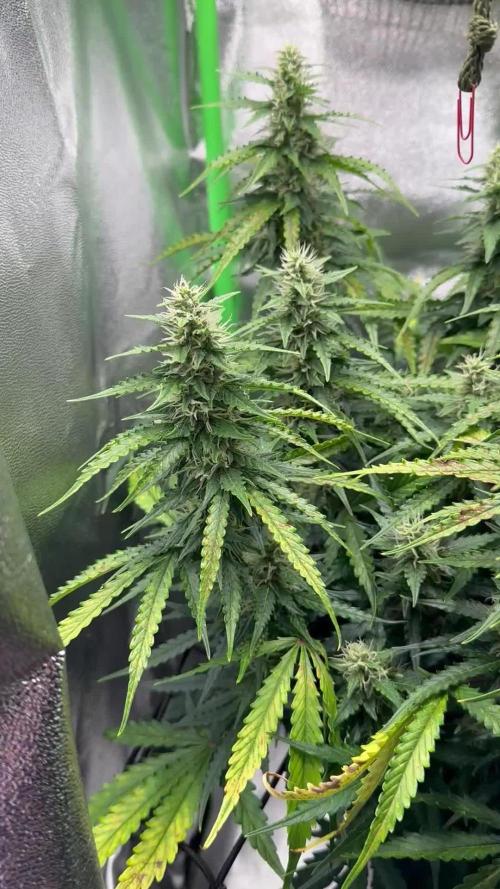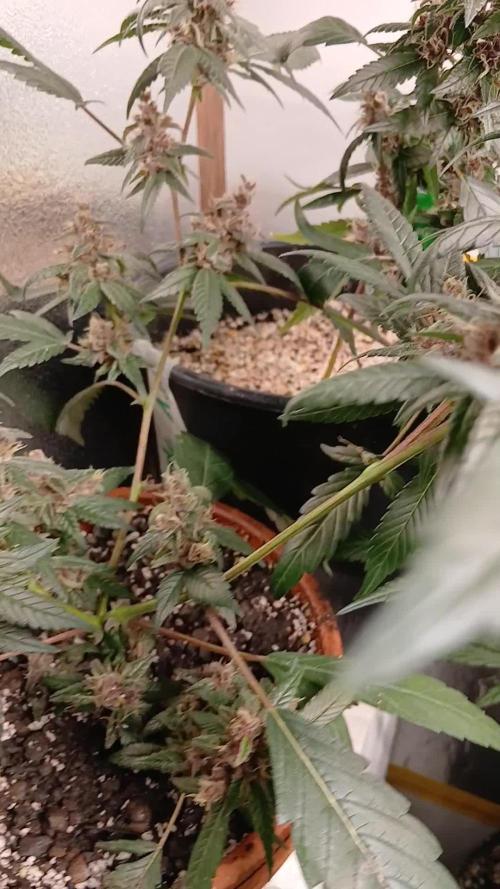The Grow Awards 2026 🏆 























Likes
Comments
Share


@Dabking
Follow
86 days from seed in soil until chopped. Roughly 40g dry weight. I ended up pressing most of it into Live rosin, however I kept some in flower form to smoke. Personally, I'm not big into the scent or smell of this strain, but it stays true to it's sativa roots and everyone who has tried it has really enjoyed it.
I'm not a big fan of this strain, purely based off the fact that my nose doesn't like the smell of this plant. It smells like chicked-peas (the stuff hummus is made from). It's very odd I know. However every one who has smoked it, including myself has enjoyed it. But if I'm picking and choosing, then this one would be near the bottom.
I ended up turning a vast majority into live rosin and it is much, much better. Amazing for listening to music and cleaning the house👌
Likes
26
Share


@olli0420
Follow
soo one was way more photogenic than the other,AGAIN. 😅 I'm proud of me😁😁
oh and how DOPE is the timelapse? 🤯🔥🔥🔥
Processing
Likes
52
Share


@CBD_Sweden
Follow
2017-09-11. Kl 12.00. Week 3 starts. I have cleaned the whole room for the new week and gave the girls water and nutes. Added videos and pics. Girl is 10 cm high.
--------------------------------------------------------------------------------------------------------------------
2017-09-12. Kl 10.00. New pic and video.
---------------------------------------------------------------------------
2017-09-13. Kl 22.00. Added new video.
---------------------------------------------------------------------------------------
2017-09-15. KL 10.00. New pics and video. The girl is 14 cm high.
---------------------------------------------------------------------------
2017-09-16. Kl 10.00. The girl is starting to grow little better now and i hope she is picking up the pace. Added new videos.
Likes
17
Share


@JonnyKush
Follow
hey growmies I decided to switch to flowering, I am using ADV nutes with the dosage recommended by them and they seem to me in great shape, tonight I will do a defoliation in order to breathe better and get as much light as possible. I'll keep you up-to-date. good growth and happy day 💚🌳
Likes
14
Share


@Stress_Bud
Follow
We started the 8th week of flowering, the time of harvest is approaching, this last week we will use flawless finish to clean the plants of nutrients before cutting them.
Possibly a week of flowering extra would be good, but in this case I will cut them after 8 weeks. The appearance is exquisite, full of resin and with an incredible smell.
————————————————————————
Empezamos la 8 semana de floración, ya se acerca el momento de la cosecha, esta última semana utilizaremos flawless finish para limpiar de nutrientes las plantas antes de cortarlas.
Posiblemente les vendria bien una semana mas de floracion,pero en este caso las cortare a partir de las 8 semanas.
El aspecto es exquisito rebosante de resina y con un olor increible.
Likes
24
Share


@3lementa1
Follow
I realized there may have been a bit of a light leak in the late morning. I taped everything up more. In the future I want to maintain better reflective integrity on the inside of the tent.
Everything looks good. The buds are still growing a little taller and filling out. The CBD Blue Shark is super frosty. It's actually absurd. Orange hairs are coming out in all plants.
I was hoping to be able to keep the exhaust window open overnight to let the overnight temps drop 10 degrees to encourage the purples in the WC genetics, but it's too humid now to have the window open without the grow light on. Otherwise the rh goes up to 70% overnight and it's not worth the risk. Next year I'll flip earlier when it's still colder and drier out for the harvest window.
This flowering period has been really cool. I've really been noticing the process of flowering. The calyxes open up and turn into pistils and sugar leaves, and more keep appearing and popping every day. It's awesome.
March 04 watered again with straight water. They're finally drinking more than once a week! The pistils seem more red today than yesterday. I got a $30 micro camera to check trichromes, they all seem clear for now (there is some glare in the pics). No amber for now at least.
March 05 found some amber trichromes
March 06 lots of leaves are going yellow. We're definitely in the home stretch.
March 06 I've been a little worried about the size of the colas. There's not much sticking out past the canopy. I've also noticed a bunch of new leaves that have started popping out and I was a little worried that the buds were foxtailing or herming. I've had temps go up to 30 a couple times in the morning before I open the window. But it seems that the buds are filling out more and getting fatter, not just foxtailing, and I think they're getting ready for one last push, not just getting full of leaves for no reason.
It changes a lot every day. Tomorrow is the 23rd week of the grow. I switched the lights on a Thursday so this Thursday will mark 8 weeks of flowering time and the beginning of my harvest window (8-9 weeks for both strains).
Likes
21
Share


@Hazeberg
Follow
Day 78: Nothing to do today.
Day 79: Nothing to do today.
Day 80: I lowered the light intensity to 6. Nothing else to do today.
Day 81: Today I pulled up some branches with some strings, as buds are too heavy and fall against the tent.
Day 82: Darkness.
--------------------------------------------------------------
You also like to get some seeds from Fast Buds?
You like a 15% discount?
Just use the following code on your next order: CSYIJC
Happy growing
--------------------------------------------------------------
🙏 Thanks for visiting and follow for daily updates 🌱
Likes
6
Share


@BedroomGrower
Follow
This variety is extremely productive with an incredible flower / leaf ratio despite its large size. I collected the first plant of this variety two days ago so I will update the data on the final weight, the taste and the effect during the Christmas period, meanwhile I wish you a Merry Christmas and happy holidays with a video dedicated to male growers 😋 obviously many wishes for a Merry Christmas and happy holidays, but without videos, to all the female growers! 😘
Data updated on January 9, 2020
Likes
12
Share


@cookingwithninja
Follow
day 30 video day 30 note crossed bridal party x pink paradise
day 31 crossed blackberry oreo bigstuff x pink paradise
day34 videos of each, a lot of photos. Rh% high I keep my terps non-volatile. Bridal rubbing sugar leafs smells like some sort of candy watermelon, blackberry neat skunky AF sugar leaf rub, pink is nice mellow I will have to check tomorrow. Dr. Thunder very oily with sugar leaf rub I swear you could deepfry with it. It also smells mellow skunky but will check again tomorrow it may have been terps overload on my fingers regarding thunder and pink paradise aromas. Pink caylaxes have shriveled and accepted pollen locations. I just don't think the seeds will be ready when harvesting in a few weeks. Start week 5 tomorrow and I don't think crosses will be ready so I will figure it out. Pink crosses would be fun next round but I have so many more selections to choose from to grow my next 4.Thunder smells like a citrus cleaner, almost pineapple front notes then a full citrus.
day35 defoliated like madd. no lie so sticky: 2 fingers lifted a ceramic cup like I was spiderman. 1 finger was a struggle.. science
Likes
46
Share


@Dr_Rook
Follow
Esta vez toca darles vida a estos esquejes de Wedding cake, bajo mi punto de vista de las mejores genéticas que hay.
Hoy hace justo una semana que llegaron y las puse en las macetas pequeñas, donde han estado 5 días hasta que las he pasado a las macetas de 1l que usaré esta vez para darles crecimiento. Las dos veces anteriores las puse del tirón en la maceta final, a ver qué tal sale así.
El clima está siendo fácil de controlar porque las condiciones son idóneas en el exterior. He cometido algún pequeño fallo como transplantarlas demasiado pronto creo yo, también algún desbarajuste con el ajuste del humidificador, ya que es nuevo y aún no controlaba bien.
Por lo general contento por cómo están evolucionando hasta el momento. A seguir dándoles cariño para que crezcan sanas y fuertes 💪
Likes
7
Share


@Skynets_Growing
Follow
Week 9 and Tamara her Flower week is quite silent. But after 2 stressfull weeks it‘s nice to have a Look how Beautiful she grow and develops. Every day I Open The Box to her I am more and more in love with her. Maybe you feel the same, but you can only see her on pics…in real life it’s awesome with this kind of plant and my Tamara …
Likes
19
Share


@lakocinka
Follow
I'm totally happy about this run. First time trying sog and tbh till now seems all good. Any feedback will be appreciated. Thanks and Happy growing































